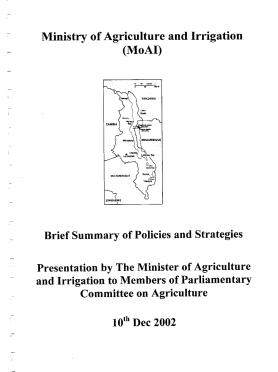Malawi Brief Summary of Policies and Strategies in the Ministry of Agriculture and Irrigation 2002
Malawi Brief Summary of Policies and Strategies in the Ministry of Agriculture and Irrigation 2002
Poverty in Malawi is widespread, deep and severe. According to the Malawi Poverty Reduction Strategy Paper, 65% of the Malawi population is poor. The consumption of basic needs (both food and non-food) of this proportion of the population is below the minimum level, estimated at MK10.47 per day. Within this category of the poor, 28.2% of the total population is living in dire poverty. The nutrition figures show that 49% of children are stunted (height for age); 25.0% are under weight and 6% are wasted. In addition, malnutrition has caused widespread mental retardation. The challenge facing the Government and other development agencies is to improve access to food and nutritional status of the people.
In 1994 the government adopted the policy of poverty reduction as a major goal of all government programmes. In collaboration with stakeholders, the Government has developed the Malawi Poverty Reduction Strategy Paper (MPRSP) which was launched by His Excellency the President Dr Bakili Muluzi in April this year. The MPRSP, in addition to other government initiatives, is the major tool which government is using to contribute to the attainment of the aspirations of the Vision 2020.
The MPRSP singles out agriculture as one of the key sectors expected to deliver and make significant contribution to poverty reduction mainly because of its contribution to the economy. Agriculture contributes 30 to 40 percent to Gross Domestic Product (GDP and 90 percent to foreign exchange earnings. Almost half of the poor households are self-employed and agriculture is the predominant economic activity, especially in rural areas. Considering that 85 percent of Malawi's population lives in rural areas, the performance of this sector, therefore, directly affects the welfare of the majority of Malawians. In the medium term, therefore, agriculture remains the major source of growth and poverty reduction.

